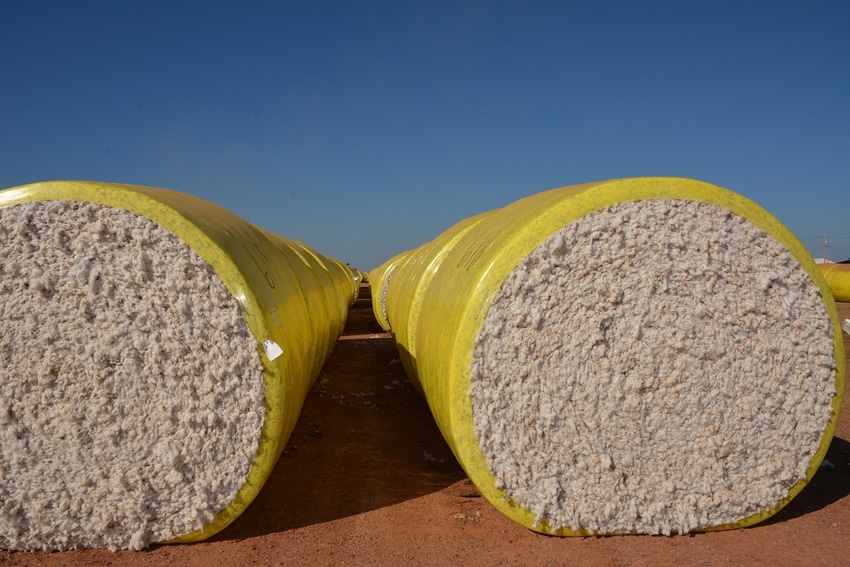
The Oklahoma cotton crop is keeping gin managers busy.
“We will end up ginning 62,000 bales this year,” says Carnegie Farmers Cooperative Manager Jeannie Hileman. “We ginned 36,000 last year, and we had already done 32,000 this year before Christmas. Our record is 42,000 — and we will beat that by 20,000 bales.”
It’s not just yield that makes this an outstanding crop, she notes. “We’re seeing the best grades we’ve ever had. Leaf trash is 3 and less, and most staple lengths are 38 and above. We had an almost perfect growing season.”
Carnegie Co-op gins cotton from about 17,000 to 18,000 irrigated acres, and 7,000 dryland acres. “In all, we pull from about 25,000 acres,” Hileman says.
Increased activity at the gin is not unique. “Farmers across the Oklahoma cotton production area are making a good crop,” she says. “Some dryland fields are yielding 3 bales per acre. It has been an outstanding year.”
She says other gin managers are reporting equally good yields, with potential to set new record bale numbers.
Kenneth Helton, assistant manager at Cotton Growers Cooperative at Altus, says they will gin 165,000 bales, “about 40,000 more than we have ever ginned before.” He talked about the crop to Southwest Farm Press back in October. “We were expecting to gin about 140,000 bales then,” he recalls. “Now, we’re about half through, with 85,000 bales ginned. We will finish in the spring.”
Grades are holding up, too. “As far as I can tell, grades have been exceptionally good.” He agrees with Hileman that gins across the area are experiencing higher than expected bale numbers. “We still have a long way to go to finish, but it’s good for the growers — and we will get it ginned.”
GOOD WEATHER FOR HARVEST
Randy Boman, research director and cotton Extension program leader for Oklahoma State University at
Altus, says this crop benefited from mostly good weather.
“September and October were both outstanding for cotton heat unit accumulation in Oklahoma. The fantastic finish allowed later-planted cotton to reach an excellent level of maturity. Rainfall during the early parts of October, November, and December resulted in some harvesting challenges, but overall the dry periods during those months provided good harvesting conditions once the fields dried out.”
He says many producers have completed harvest, and moved on with tillage or other management tasks. “The good news is that the 2016 crop is going to be an excellent one for Oklahoma producers and ginners. Color grades have been good to excellent, with about 44 percent 11 and 21, and about 37 percent 31 color. Leaf grades and overall distribution have been good, with 85 percent grades 1, 2, and 3, and an average of 2.7. Staple has averaged 36.6, with more than 56 percent 37 or longer.”
Some high micronaire has shown up, with 13 percent of samples above 5.0, but 86 percent has been in the 3.5 to 4.9 range. Fiber strength has averaged 30.8 grams per tex, with 80 percent 30 or higher. Uniformity is averaging 81.6 percent, and bark contamination is currently very low — only 5 percent of the bales.
Earlier cotton was mostly harvested by picker, Boman says, likely a contributing factor to higher uniformity and reduced bark contamination.
RECORD AVERAGE YIELD
“At the end of 2016, many gins were just reaching the halfway point with estimates of ginning totals. If this holds, the state of Oklahoma could still reach the December NASS estimate of 565,000 bales from 285,000 harvested acres. That would be the second consecutive year for record yield, at 952 pounds.
“This would be the largest crop in terms of bale volume since 1949, but that crop was produced on 1.3 million harvested acres. Many Oklahoma producers are experiencing record yields for both dryland and irrigated fields, and 2016 will be a year for many to remember happily.”
Boman says OSU variety trials have been harvested and ginned. “We hope to get fiber quality data back and get results posted online and distributed to our newsletter clientele soon. Along with outstanding yields and quality producers are experiencing, our on-farm variety trials will be setting records this year. Multiple new entries have performed extremely well, including those with XtendFlex and Enlist technologies. Several irrigated locations have entries that will exceed 4 bales per acre.”
Boman also reminds producers that the Red River Crops Conference will be at Childress, Texas, January 24-25. “Now is the time for producers to do their homework and begin planning for the 2017 growing season.”
ACREAGE BOOST LIKELY
Those bumper yields and positive moisture levels will boost cotton acreage again in 2017, Hileman says. “I expect to see a significant increase in acreage next year. Cotton price is not great, but it looks better than anything else.”
She says the outlook would be a lot better if cotton moved up to 80 cents. “We might not be able to gin all the cotton we’d grow if we hit 80 cents.”
Helton says the low price for grains will encourage more cotton acreage. “Cotton will replace some wheat acreage in Oklahoma.”
About the Author(s)
You May Also Like






